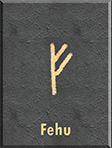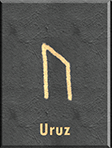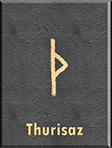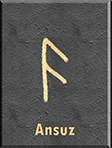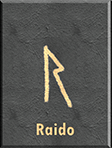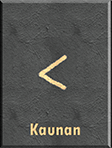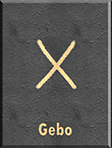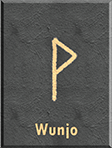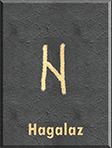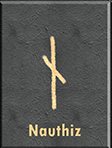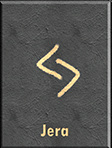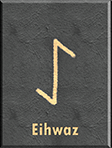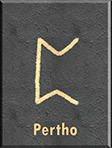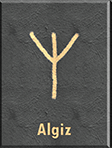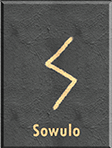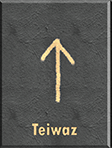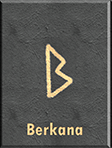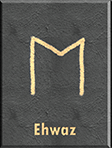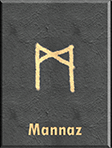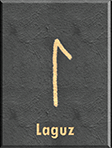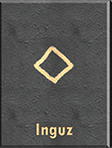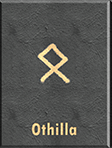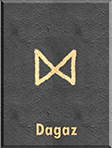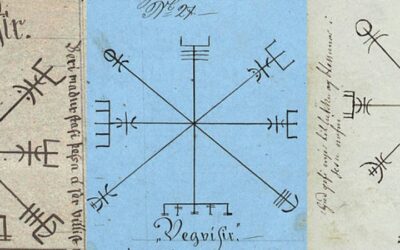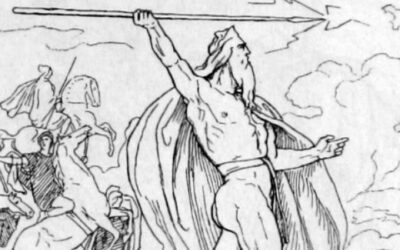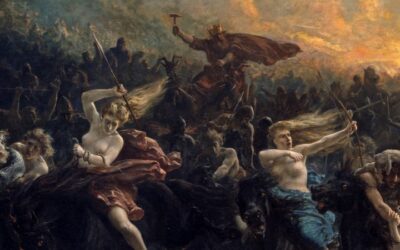Elder Futhark – The Norse Rune Complete Guide
What Are Norse and Viking Runes?
The ancient Norsemen knew 24 powerful runes that they used for magical purposes. These symbols came from an even more extensive set known as the Elder Futhark and included not only transliteration but also meaning in various languages like Old English or Latin to assist with casting spells!
The following information may be useful: -Each rune had its own specific purpose; some were utilized during rituals while others might have served more general use such as writing down one’s thoughts on paper-
Norse Runes Elder Futhark Quick Guide
This quick guide describes each Rune, its symbol, meaning & pronunciation with a link to a detailed page dedicated to each Norse Rune.
The complete guide below provides a description of the runic language, how it developed, its use, how the language evolved, the influence Norse and Viking runes had on the Italic alphabet and how to read it.
1. Fehu
Fehu is the first rune
Literal Translation: Wealth
English Transliteration: “F”
Symbolism: Cattle, certainty, good fortune
2. Uruz
Uruz is the second rune
Literal Translation: Aurochs
English Transliteration: “U”
Symbolism: Strength, burden
3. Thurisaz
Thurisaz is the third rune
Literal Translation: Thorns
English Transliteration: “Th”
Symbolism: Thor, giant, slayer
4. Ansuz
Ansuz is the fourth rune
Literal Translation: A God
English Transliteration: “A”
Symbolism: Odin, aesir, divine inspiration
5. Raido
Raido is the fifth rune
Literal Translation: Riding
English Transliteration: “R”
Symbolism: Horses, long journey, wheels
6. Kaunan
Kaunan is the sixth rune
Literal Translation: Torch
English Transliteration: “K/C”
Symbolism: Disease, pain, burning
7. Gebo
Gebo is the seventh rune
Literal Translation: Gift
English Transliteration: “G”
Symbolism: Trade, contracts, profit
8. Wunjo
Wunjo is the eigth rune
Literal Translation: Joy
English Transliteration: “W”
Symbolism: Child-like, wonder, bliss
9. Hagalaz
Hagalaz is the ninth rune
Literal Translation: Hailstones
English Transliteration: “H”
Symbolism: Disaster, radical change, endurance
10. Nauthiz
Nauthiz is the tenth rune
Literal Translation: Need Fire
English Transliteration: “N”
Symbolism: Bare necessities, desperation, conservation
11. Isa
Isa is the first eleventh rune
Literal Translation: Icy
English Transliteration: “I”
Symbolism: Concentration, stillness, identity
12. Jera
Jera is the twelfth rune
Literal Translation: A Year
English Transliteration: “J/Y”
Symbolism: Harvest time, time cycles, honest work
13. Eihwaz
Eihwas is the thirteenth rune
Literal Translation: Yew Trees
English Transliteration: “Ey”
Symbolism: Life and death, immortality, initiation
14. Pertho
Pertho is the fourteenth rune
Literal Translation: Pear Wood (Unknown)
English Transliteration: “P”
Symbolism: Luck, gambling, music
15. Algiz
Algiz is the fifteenth rune
Literal Translation: Elk
English Transliteration: “Z”
Symbolism: Protection, nature’s blessing, medicine
16. Sowulo
Sowulo is the sixteenth rune
Literal Translation: Sun
English Transliteration: “S”
Symbolism: Fire, eyes, victory
17. Teiwaz
Teiwaz is the seventeenth rune
Literal Translation: Of Tyr
English Transliteration: “T”
Symbolism: Justice, sacrifice, principle
18. Berkana
Berkana is the eighteenth rune
Literal Translation: Birch Goddess
English Transliteration: “B”
Symbolism: Sanctuary, rebirth, mothers
19. Ehwaz
Ehwaz is the nineteenth rune
Literal Translation: Horse
English Transliteration: “E”
Symbolism: Trust, partnership, domestic animals
20. Mannaz
Mannaz is the twentieth rune
Literal Translation: Of Man
English Transliteration: “M”
Symbolism: Learning, crafting, mortality
21. Laguz
Laguz is the twenty first rune
Literal Translation: Lake
English Transliteration: “L”
Symbolism: Rain, imagination, dreams
22. Inguz
Inguz is the twenty-second rune
Literal Translation: From Seed
English Transliteration: “Ng”
Symbolism: Creation, life cycle, inspiration
23. Othilla
Othilla is the twenty-third rune
Literal Translation: Of Father
English Transliteration: “O”
Symbolism: Odin, heritage, inheritance
24. Dagaz
Dagaz is the twenty-fourth rune
Literal Translation: Day
English Transliteration: “D”
Symbolism: Awakening, invisibility, the unknown
What is the Elder Futhark?
The Elder Futhark is the oldest form of the European runic alphabet, dating back to the 2nd or 3rd century AD. The elder futhark consists of 24 runes, which represent the sound values of the Proto-Germanic languages that were spoken at the time. The elder futhark was used primarily for writing inscriptions on stone and wood, but it was also sometimes used for magical or divinatory purposes. The elder futhark fell out of use around the 8th century AD, but it was later reintroduced and adapted by various groups, including the Vikings. Today, the elder futhark is still used by some people for a variety of purposes, including writing inscriptions, creating artwork, and casting spells.
The elder futhark developed alongside another, younger runic alphabet used by the Saxons in the 5th century, the Futhorc alphabet. The elder futhark consists of 24 letters, while the futhorc has 26. The extra letters in the futhorc were used to represent sounds that did not exist in Old English, such as th and ng. In addition, the futhorc was better suited to writing on parchment, as it made use of straight lines and easy-to-write letters. As Saxons invaded the British Isles the Futhorc became the main written language in much of Europe.
The elder futhark continued in use particularly in Scandinavia, but was eventually replaced by the simplified Younger Futhark, with only 16 runes instead of 24, and simpler line structure. The elder futhark, futhorc and younger futhark all existed at the same time until they were replaced by the latin alphabet as most of Europe became Christianized from the 10th to the 12 centuries. The tablets and books used by scholars at the time to translate between all 4 alphabets are why we know as much about them as we do now!
Before the Elder Futhark
The Elder Futhark is the oldest form of the Germanic runic alphabet, dating back to the 2nd or 3rd century AD. Writing before the Elder Futhark was largely confined to the Latin alphabet, but there are a few notable examples of Germanic runes being used for inscriptions. The earliest known examples come from the 1st century AD, and include the so-called Zwinger III rune stone from Sweden and the Vimose inscriptions from Denmark. These early inscriptions suggest that runes were primarily used for magical or religious purposes, rather than for communication. It wasn’t until the Elder Futhark appeared that runes began to be used more widely for writing. The Elder Futhark consists of 24 runes, each with its own meaning and sound. This system of writing was used throughout Scandinavia, Germany, and Iceland during the medieval period. In addition to being used for communication, runes were also used for decorative purposes. Many churches and other buildings from this period feature intricate rune carvings, which add to our understanding of this fascinating form of writing.
Development of the Elder Futhark
The various simple rune scripts used by proto Germanic tribes eventually mixed and became more codified as Germanic people began migrating to western and northern Europe after the fall of the Roman Empire. The Germanic migration period was a time of great upheaval in Europe. Beginning in the 4th century, groups of people from the Germanic tribes began to migrate westward in search of new lands. This mass movement of people had a profound impact on the history of Europe. The migration period marked the end of the Roman Empire and the beginning of the Middle Ages. It also eventually led to the spread of Christianity and the development of new languages and cultures. One of the most significant aspects of this period was the introduction of the Elder Futhark, the earliest form of the Germanic runes. These distinctive letters were used for writing, carved into stone, and cast in metal. Today, they provide a valuable record of the history and culture of this fascinating period.
Elder Futhark Height of Use
Elder Futhark was used throughout northern Europe, Scandinavia, and the British Isles during the Early Middle Ages. The Elder Futhark was used to write a variety of languages, including Old Norse, Gothic, and Anglo-Saxon. Many of the Elder Futhark runes also have magical or religious significance, and they were often used in charms and amulets. The best-known Elder Futhark inscription is the Kylver Stone, which was found in Sweden and contains a verse from the Nordic poem “The Havamal.” The Elder Futhark continued to be used after the introduction of the Latin alphabet to the Germanic world, and it was not until the Medieval period that it finally fell out of use.
How do you read Norse Runes?
The ancient Norsemen were renowned for their Runic alphabet. Consisting of vertical lines, branches and twigs jutting out from them in different directions; runes could be written both left-to-right as well as vice versa depending on how they wanted to spell things like words or sounds that started with specific letters – this is because each symbolized a phonetic value which depended upon its shape: Some looked more similar while others had variations such
A runic letter would’ve most likely begun with a horizontal bar going down and then turning curly.
Evolution of Elder Futhark into Futhorc
Futhorc is the name given to the Anglo-Saxon runes, as opposed to Elder Futhark, which is the more commonly used name for the Continental Germanic Runes. Futhorc was named after the first six letters of the Latin alphabet, F, U, TH, O, R and C, which are also the first six runes of this alphabet. Elder Futhark is a far more ancient system, dating back to at least 150 AD. Futhorc however only began appearing in England from around the 5th or 6th century onwards. There are several differences between the two systems. The most obvious difference is that Elder Futhark has 24 runes while Futhorc has 28. This is because Futhorc includes extra runes for certain sounds which did not exist in Germanic languages but did in Anglo-Saxon English. For example, there are three different runes for the sound “ng” as found in words such as “singer” or “long”. These extra runes were also used to represent abbreviations and dialectical variants. Another significant difference is that while Elder Futhark is written left to right, Futhorc can be written either left to right or right to left. This feature is likely due to the influence of Latin on Anglo-Saxon culture. Finally, Futhorc uses straight lines while Elder Futhark uses curved lines. This is simply a matter of aesthetics and does not affect legibility. Despite these differences, both alphabets are still fundamentally alike and can be used interchangeably for most purposes.
Simplification of Elder Futhark into Younger Futhark
The Younger Futhark is the younger version of the Futhark runes. It was used in Scandinavia during the Viking Age, between the 8th and 11th centuries. The Younger Futhark has 16 runes, which are divided into three groups: eight Freyr’s Aett (F); four Hagal’s Aett (H); and four Tyr’s Aett (T), named after the Norse gods Frey, Hagal and Tyr respectively. The Younger Futhark is derived from the Elder Futhark, which was used during the Migration period, between the 2nd and 8th centuries. The Elder Futhark has 24 runes, which are divided into four groups: eight Fehu’s Aett (F); six Ansuz’s Aett (A); six Thurisaz’s Aett (Þ); and four Raido’s Aett (R). The Younger Futhark is a simplified version of the Elder Futhark, containing only those runes that were considered essential for writing Old Norse.
Period of Coexistance and Translation Between Runes
Runic alphabets, or futharks, were once used by Germanic peoples for writing. The three best-known futharks are Elder Futhark, Younger Futhark and Anglo-Saxon futhorc. All three are derived from the common Germanic alphabet, which was known as fuþark or fuþorc. Elder Futhark was the oldest form of the alphabet, and it was used throughout Scandinavia during the Migration period. Younger Futhark was developed in the 9th century, and it quickly replaced Elder Futhark in Scandinavia. Anglo-Saxon futhorc was used in England during the early Middle Ages. It is a direct descendant of Elder Futhark, but it also includes some Anglo-Saxon letters that were not part of the original Germanic alphabet. With all 3 being in use in different parts of Europe during the period of Christianization, latin writings at the time would often be translated from one to the other for purposes of trade, religion, historical documents and poetry, and through these comparative translations we have been able to discover the runes modern equivalents.
Takeover of Italic Alphabet
These languages were gradually replaced by the Italic alphabet, which became the standard alphabet for Germanic languages during the Medieval period. In the early days of writing, cultures around the world developed their own alphabetical systems, however, by the Middle Ages, this system had been largely replaced by the Latin alphabet. Today, the Latin alphabet is used by most languages in Europe and around the world, although some cultures still use other alphabets.
Influence of Runes on Italic Alphabet
The old Italic alphabet used in the late Roman Empire merged with some aspects of the other European languages, including the Futharks, during the period of Christianization in the Middle Ages, to become very similar to the modern Latin alphabet we still use today. Influences from the Futharks include the introduction of the “J”, “G”, “U” and “W” characters, which had no Italic equivalent.
Revival of Runic Languages
Sophus Bugge, a Norwegian philologist and linguist, is credited with the discovery of the Elder Futhark script. The script gets its name from the first six letters of the alphabet (f, u, þ, a, r, k), which are also the most commonly used letters in the script. Sophus Bugge was born in 1833 in Christiania, Norway (now Oslo), and studied at the University of Christiania before moving to Copenhagen, Denmark, to continue his studies at the University of Copenhagen. In Copenhagen, he met Rasmus Rask, who would become his mentor, and began to work on a dictionary of the elder futhark. This work was published in 1866 and remains an important resource for scholars of this early alphabet. Bugge also helped to decipher the Rök Stone, a large boulder inscribed with runes that date back to the 9th century. He died in 1907 in Christiania.
The Elder Futhark Today
Today, Elder Futhark is enjoying a revival among people who are interested in Norse culture and history. While Elder Futhark is not used as a spoken language, it can be seen in a number of different places. Elder Futhark runes are often used as tattoos or jewelry, and they appear on a variety of merchandise, from t-shirts to coffee mugs. In addition, Elder Futhark can be found in many video games and other forms of popular culture. As interest in Norse culture continues to grow, it is likely that Elder Futhark will become even more prevalent in the years to come.
Here is some more recommended reading
The Vegvisir – Famous Viking Symbols
The vegvisir is a symbol dating back to medieval Icelandic magical staves, designed to be worn as an amulet or spell cast by the user.
The Aesir – Rulers of the Norse Gods
The Norse people had rich and complex religious beliefs before the introduction of Christianity. Norse mythology revolved around a pantheon of gods and goddesses, including Odin, Thor, and Freya. These deities represented natural phenomena, such as fertility, storms, and war.
Norse Mythology – A Complete Overview
Norse mythology is a collection of stories about gods and heroes from Scandinavia. These stories were passed down orally for centuries before being written down, and they provide an important glimpse into the culture and beliefs of the Norse people.

